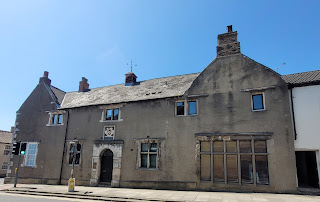Sherburn-in-Elmet, 15th October 1645
If Naseby was the start of the end of the Royalist cause in the First Civil War, Stow the knock out blow, Sherburn-in-Elmet was one of the heaviest blows in between. Oft overlooked, this very important battle garners little attention - Nick Lipscombe devotes a whole two sentences to it in his Atlas of the English Civil War, and doesn't even mark it on any of the maps.
Oh, and this post hits a bit of a milestone, being post number 400. A celebratory small sherry might be in order later.
Naseby saw the Army Newly Modelled decimate the foot element of the King's main field army, a large proportion of the King's cavalry, the Northern Horse being able to flee. Lord Digby taking the horse north with the plan of joining Royalist forces in Scotland under the command of Montrose.
 |
| The old grammar school, built 1612 |
Sherburn was garrisoned with between 800 and 1500 foot, and possibly 400 horse under the command of Colonel Wren.
Digby was approaching Sherburn from the north, and captured a Parliamentarian messenger, who informed him that the town's garrison was unaware of Digby's presence.
 |
| The northern part of the battlefield |
Digby advanced meeting the garrison about half a mile to the north of the town. Taken by surprise the garrison quickly capitulated, either fleeing the battlefield or being captured (between seven and eight hundred taken prisoner according to Royalist sources). A large number of Digby's men then went on a celebratory drinking and looting spree in the town.
Unbeknownst to them the alarm had been raised and a Parliamentarian force of three regiments of horse were hot footing (or should that be hot hoofing?) it to Sherburn from the south (those of Colonels Copley, Lillburne, and Lord Fairfax). They were spotted about half a mile south of the town. Some of Digby's men formed up to meet the Parliamentarian force, and the two sides met on the fields aside of the old Roman road to South Milford.
 |
| The southern part of the battlefield |
The disorganised Royalists fought well against a superior sized force, routing many Parliamentarian horse who fled through the town. Confusion was rife, these fleeing Parliamentarians may have actually been Royalist men being pursued by their foes. Whoever they were, these fleeing men caused panic in the town, Royalist looters fled alongside them.
Much of the Parliamentarian horse were able to reform, pursuing the Royalists through the town, where fighting was heavy. The captured garrison were freed along with their weapons and equipment.
 |
| View of the northern part of the battlefield from All Saints churchyard |
Digby's men attempted a stand to the north of the town before fleeing.
Royalist casualties were very heavy. It is believed that more Northern Horse officers were killed or captured at Sherburn than at Marston Moor. Peter Young believed that the original strength of Digby's force was about 1600, with only 6-700 escaping Sherburn to the safety of Skipton. From Skipton they crossed the Pennines into Cumberland, before making it to Scotland where they would face defeat at Annan Moor, and again at Carlisle Sands on the 24th October, where their surviving numbers were so few that they effectively stopped being a fighting force.
Just as important as this considerable reduction in the Northern Horse, was the capture of Lord Digby's personal coach, which contained a considerable amount of compromising material in the Secretary of State's correspondence.
What's there now?
Much of the surrounding fields have been lost to development as the town has become part of the commuter belt of Leeds. The town's defensive earthworks are long since gone, the earthworks close to the C12th All Saints Church are believed to be much earlier and connected to a palace built on land given by King Athelstan to the Archbishopric of York.
 |
| All Saints |
There are a number of buildings still standing that will have witnessed the fighting in the town.
 |
| 63-65 Kirkgate |
63 and 65 Kirkgate were a farmhouse at the time of the battle. |
The old grammar school, which now serves as the village hall, located next to the main road through the town, must surely have witnessed the fierce fighting that took place as the Royalists fled north.



.jfif)







That sounds like a fun, small skirmish to fight on the table top.
ReplyDeleteIt would be entertaining trying to get the distracted men to stop and fight.
Delete